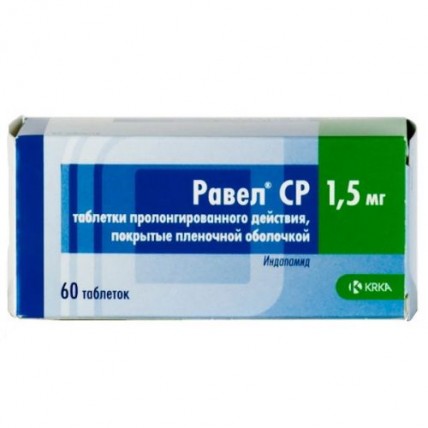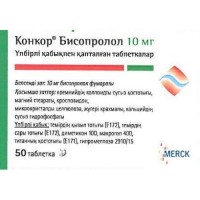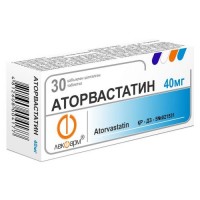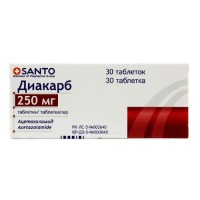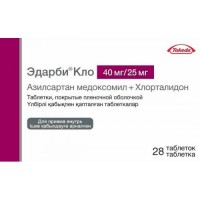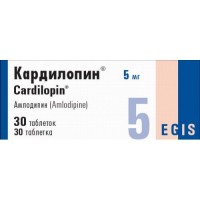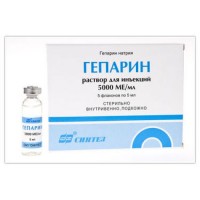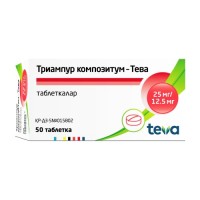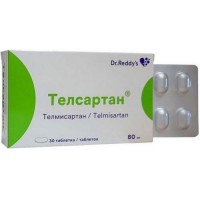Ravel CP 60s 1.5 mg sustained release tablets
- $18.20
The instruction for medical use
of RAVEL® SR medicine
the Trade name
of RAVEL® SR
the International unlicensed
name Indapamid Lekarstvennaya a form
of the Tablet of the prolonged action, film coated 1.5 mg
Structure
One tablet contains
active agent - indapamid 1.5 mg,
excipients: gipromelloza, tsellaktoza (75% of alpha lactose and 25% of powder of cellulose), povidone, silicon dioxide colloidal anhydrous, magnesium stearate,
film cover: Opadry Y-1-7000 (a gipromelloza, a macrogoal 400, the titan dioxide (E171))
the Description
of the Tablet of round shape, with slightly biconvex surface, film coated white color.
Pharmacotherapeutic group
Diuretics. Not thiazide diuretics operating on a cortical segment of a Henle's loop. Sulfonamides. Indapamid.
The ATX C03BA11 code
the Pharmacological
Pharmacokinetics Absorption Fraction properties of an indapamid quickly and almost is completely soaked up in digestive tract. Meal slows down absorption speed a little, but does not affect amount of the absorbed drug. The maximum concentration in blood serum is reached approximately in 12 hours after administration of drug. After achievement of stable concentration, changes in concentration in blood serum in a break between two doses decrease.
Distribution, metabolism and removal
Linking of an indapamid with proteins of plasma makes 79%, elimination half-life - from 14 to 24 hours (on average, 18 hours). Equilibrium concentration is reached in 7 days. Repeated reception does not lead to accumulation of an indapamid.
Indapamid, is generally metabolized in a liver. 70% of an indapamid are removed by kidneys, mainly in the form of inactive metabolites (the fraction of not changed drug makes about 5%). 22% of drug are removed with a stake in the form of inactive metabolites.
At patients with a renal failure the pharmacokinetic parameters of drug do not change.
RAVEL® SR-pharmacodynamics derivative streptocide from group of thiazide diuretics. Drug inhibits absorption of sodium in a cortical segment of renal tubules that leads to increase in discharge of ions of sodium and chlorine with urine, and, thereby leads to strengthening of a diuresis. To a lesser extent drug increases removal of potassium ions and magnesium. In addition to diuretic effect, indapamid also has the vascular effect connected with decrease in arteriolar and general peripheric vascular resistance.
At monotherapy possesses antihypertensive action lasting 24 hours.
Indapamid reduces a hypertrophy of a left ventricle. Antihypertensive effect of tiazidopodobny diuretics, including indapamid, at higher doses amplifies, and undesirable consequences continue to grow.
Researches of short, average and long-term treatment showed what indapamid, unlike other diuretics, does not interfere with metabolism of lipids (general cholesterol, triglycerides, the XC LDL and the XC LPVP), and does not interfere with metabolism of carbohydrates, even at patients with arterial hypertension and diabetes.
Indications
- arterial hypertension (maintenance therapy)
the Route of administration and doses
Adult
Inside, on 1 tablet (1.5 mg) once a day, it is desirable in the morning. The tablet should be swallowed entirely, without chewing, washing down with enough water.
The course of treatment is selected individually, according to the recommendation of the attending physician.
At higher doses, antihypertensive action of an indapamid does not increase, but removal of salts (saluretichesky effect) increases.
At patients of advanced age, creatinine level in plasma can change depending on age, weight and a floor. Dose adjustment is not required to patients of advanced age with normal or easy extent of depression of function of kidneys.
In a heavy renal failure (the clearance of creatinine is lower than 30 ml/min.), treatment is contraindicated.
Thiazide and tiazidopodobny diuretics are most effective only at normal or slightly reduced function of kidneys.
In a heavy liver failure the treatment is contraindicated.
Side effects
Often (& gt, 1/100 to & lt, 1/10)
- makulopapulezny rash
- a hypopotassemia
Infrequently (& gt, 1/1.000 to & lt, 1/100)
- nausea, vomiting
- a purpura (at patients with predisposition to allergic and asthmatic reactions)
it is rare (& gt, 1/10.000 to & lt, 1/1.000)
- dizziness, fatigue, a headache, paresthesia
- nervousness
- cough, pharyngitis, sinusitis
- nausea, a constipation or diarrhea, a digestive disturbance, an abdominal pain, dryness
in a mouth
- an asthenia
Very seldom (& lt, 1/10.000),
- thrombocytopenia, a leukopenia, an agranulocytosis, aplastic anemia, gemoli-
tichesky anemia
- arrhythmia, arterial hypotension
- pancreatitis
- an abnormal liver function, pancreatitis
- a renal failure, infections of urinary tract, a nocturia,
a polyuria
- a Quincke's disease and/or a small tortoiseshell, a toxic epidermal necrolysis, Stephen Johnson's syndrome, a hemorrhagic vasculitis.
- reaction of photosensitivity
- a hypercalcemia, a hypopotassemia
does not know whether are connected with administration of drug (it is impossible to estimate on the basis of the available data):
- possibility of hepatic encephalopathy in a liver
failure
- lengthening of an interval of QT on the electrocardiogram
- increase in level of uric acid and glucose in blood plasma during
treatment: at patients with gout or diabetes, a glucosuria
it has to be very careful the expediency of data diureti-
chesky means
- possible aggravation of already existing disseminate
lupus erythematosus
- a hyponatremia with a hypovolemia, leading to dehydration and ortostati-
chesky hypotension is weighed. Simultaneous loss of ions of chlorine can lead to
a secondary compensatory metabolic alkalosis (frequency and degree
of this effect weak).
Contraindications
- hypersensitivity to an indapamid, other streptocides
or components of drug
- a heavy renal failure
- hepatic encephalopathy or heavy abnormal liver functions
- a hypopotassemia
- children's and teenage age up to 18 years (safety and efficiency
are not studied)
- pregnancy and the period of a lactation
not recommended combinations
Simultaneous use with drugs of lithium can lead Medicinal interactions to increase in concentration of lithium in blood plasma with signs of overdose, as well as at a beznatriyevy diet (lithium removal reduction). However, in need of use of diuretics, it is necessary to control systematically lithium level in blood plasma and to carry out a korrigirovaniye dosed
the Combinations demanding care
a) the drugs causing ventricular tachycardia:
- Ia a class of antiarrhytmic drugs (quinidine, hydroquinidine, dizopi-
ramid)
- the III class of antiarrhytmic means (Amiodaronum, sotalol, dofetilid,
ibutilid)
- some antipsychotic drugs: fenotiazina (Chlorpromazinum,
tsiamemazin, levomepromazinum, thioridazine, trifluoperazin)
- benzamides (amisulprid, Sulpiridum, sultoprid, tiaprid)
- phenyl propyl ketones (Droperidolum, a haloperidol),
- other: bepridit, tsizaprid, difemanit, erythromycin IV, galofantrin,
mizolastin, pentamidine, sparfloksatsin, moxifloxacin, Vincaminum IV.
Simultaneous use of an indapamid with any of these drugs, especially in the presence of a hypopotassemia, increases risk of developing ventricular arrhythmia, especially ventricular tachycardia like pirouette. Before use of this combination the control of a hypopotassemia is necessary. Level of electrolytes in blood plasma and the ECG is necessary control. Apply substances which do not cause risk of developing ventricular tachycardia in the presence of a hypopotassemia.
b) non-steroidal anti-inflammatory drugs (system way), including selection TsOG-2 inhibitors, high doses of salicylic acid (≥ 3 g/days): reduction of antihypertensive effect of an indapamid is possible. Risk of an acute renal failure at patients with dehydration (decrease in glomerular filtration). It is necessary to control function of kidneys in an initiation of treatment. to give to the patient
of water c) inhibitors the angiotensin-the converting enzymes (ACE): AKF inhibitors in an initiation of treatment can cause sudden hypotension and/or an acute renal failure in patients with already existing deficiency of sodium (especially at patients with a renal artery stenosis).
In hypertensia if the previous therapy by diuretic means caused deficiency of sodium, it is recommended to stop use of diuretic means in 3 days prior to treatment by AKF inhibitors and, if necessary, to start reception without kaliysberegayushchy diuretics over again or it is possible to appoint treatment from a low initial dose of AKF inhibitor and to increase a dose gradually.
At patients with chronic heart failure, treatment needs to be begun with very low doses of AKF inhibitor, it is desirable after decrease in doses, without kaliysberegayushchy diuretics.
At all patients, within the first weeks of treatment it is necessary to carry out by AKF inhibitors control of function of kidneys (creatinine level in blood plasma).
Other drugs causing a hypopotassemia:
- B (IV) Amphotericinum
- glyuko- and - mineral corticosteroids (system)
- tetrakozaktid
- the stimulating depletive
Increases risk of emergence of a hypopotassemia (additive effect) in this connection it is necessary to control and regulate carefully potassium level in blood plasma. At the patients who are at the same time accepting a foxglove it is necessary to take drug with caution. Such patients have to accept it without the stimulating depletive.
Baclofenum increases antihypertensive effect. It is necessary to drink a large amount of water, in an initiation of treatment it is necessary to carry out systematic control of function of kidneys.
The hypopotassemia increases risk of development of toxic action of a foxglove, at simultaneous use it is necessary to control and regulate potassium level in blood plasma and to carry out the ECG, if necessary – to change treatment.
Combinations which it is necessary to consider
Kaliysberegayushchy diuretics (amiloride, Spironolactonum, Triamterenum). These combinations are useful to some patients, but can cause emergence of a hypopotassemia or hyperpotassemia in patients with a renal failure or diabetes. It is necessary to control potassium level in blood plasma, the ECG, if necessary — to change treatment.
Metformin povysht risk of development of a laktatsidoz owing to development of the renal failure connected with reception of diuretic means and, in particular with loopback diuretics it is not recommended to apply metformin if creatinine level in blood plasma exceeds 15 mg/l (135 µmol/l) at men and 12 mg/l (110 µmol/l) - at women.
At patients with dihydration because of diuretics, especially at reception of high doses of iodinated contrast agents, risk of developing an acute renal failure increases, it is necessary to restore water balance before purpose of yodokontrastny means.
Imipraminum-like antidepressants, neuroleptics increase expressiveness of antihypertensive effect and increase risk of developing orthostatic hypotension (additive effect).
Salts of calcium increase risk of emergence of a hypercalcemia as a result of decrease in discharge of calcium with urine.
Cyclosporine, takrolimus can increase creatinine level in blood plasma at not changed concentration of the circulating cyclosporine, even in the absence of water and/or deficiency of sodium.
Corticosteroids, tetrakozaktid (systemic action) lead to reduction of expressiveness of hypotensive action (delay of water and sodium).
Special instructions
to Patients with a renal and/or liver failure, the disturbance of water and electrolytic balance, a hyperparathyreosis sick with disturbance of a warm rhythm, or to patients with the combination therapy, a hyperuricemia (which is especially followed by gout or an uratny nephrolithiasis), drug it is necessary to take with caution.
Special preventions
At patients from the liver broken by function, thiazide diuretics can cause hepatic encephalopathy, especially at an electrolytic imbalance. In this case reception of diuretic means needs to be stopped immediately.
Photosensitivity
At reception of tiazid and tiazidopodobny diuretics cases of reaction of photosensitivity were registered. If during treatment there is a reaction of photosensitivity, then therapy is recommended to be stopped. In need of repeated use of an indapamid, it is recommended to protect open sites of skin from the sun or from artificial UF-of radiation.
Excipients
This medicine contains lactose. Patients with a rare hereditary disease of intolerance of a galactose, deficiency of Lappa lactase or disturbance of absorption of glucose and a galactose should not take this drug.
Special precautionary measures
sodium Level in blood plasma
Diuretics can cause a hyponatremia, sometimes with very serious consequences. Sodium level is measured in blood plasma prior to treatment, and then is regular through strictly certain periods. In an initial stage the decrease in level of sodium in blood plasma can proceed asymptomatically therefore regular control has huge value. At patients of advanced age and patients with cirrhosis, control has to be more frequent.
Potassium level in blood plasma
the Main risk of treatment by thiazide and tiazidopodobny diuretics – decrease in level of potassium and development of a hypopotassemia. The risk of emergence of a hypopotassemia (& lt, 3.4 mmol/l) has to be prevented at certain groups with high risk, namely: at badly eating patients and/or at the same time taking several drugs, at patients of advanced age, patients with cirrhosis with hypostases and ascites, at patients with coronary heart disease and heart failure. At such patients the hypopotassemia increases cardiotoxicity of drugs of a foxglove and risk of developing of arrhythmias. Patients with the extended QT interval also treat risk group, irrespective of the reason - inborn or induced by drugs.
The hypopotassemia (also as well as bradycardia) is the contributing factor of developing of heavy arrhythmias, in particular, potentially life-threatening disturbances of a warm rhythm like pirouette.
At such patients it is necessary to control as often as possible potassium level in blood plasma. The first measurement of level of potassium in blood plasma has to be taken within the first week of treatment.
At detection of low level of potassium, its correction is required.
Calcium level in plasma of a krovitiazida and tiazidopodobny diuretics can lower calcium discharge with urine and lead to slight temporary increase of concentration of calcium in blood plasma. The expressed hypercalcemia can be a consequence of a hyperparathyreosis undetected earlier. Treatment by means of diuretics has to be stopped before the planned inspection of function of epithelial bodies.
Level of uric acid
At patients from the uric acid raised by concentration gout attacks are possible.
Function of kidneys and diuretics
Thiazide and tiazidopodobny diuretics are most effective only at normal or minimum reduced function of kidneys (creatinine level in blood plasma & lt, 25 mg/l, that is adults have 220 µmol/l). At elderly people, creatinine level in blood plasma can change depending on age, weight and a floor.
The secondary hypovolemia caused by loss of water and sodium at treatment by diuretics leads to decrease in glomerular filtration in an initiation of treatment. It can lead to increase in level of urea and creatinine in blood plasma. At patients with normal function of kidneys, such temporary renal failure usually does not lead to serious consequences, nevertheless, its emergence substantially can strengthen the available renal failure.
Athletes
Athletes have to consider that this drug contains active agents which can give positive reaction to doping tests.
Pregnancy and the period of a lactation
Pregnant women cannot use diuretic drugs in physiological hypostases during pregnancy at all. Diuretics can lead to the fetoplacental ischemia menacing to growth of a fruit.
Breastfeeding is not recommended as indapamid gets into breast milk.
The feature of influence of medicine on ability to run the vehicle or potentially dangerous
Indapamid mechanisms does not affect vigilance, but the different reactions connected with a lowering of arterial pressure, especially in an initiation of treatment or at addition of another antihypertensive drug that can lead to disturbance of ability to run the vehicle or potentially dangerous mechanisms are in certain cases possible.
Overdose
Symptoms: disturbances of water and electrolytic balance (hyponatremia, a hypopotassemia) which are shown in the form of nausea, vomiting, arterial hypotension, a spasm, dizziness, drowsiness, confusion of consciousness, a polyuria or an oliguria, perhaps, the aggravated anury (owing to a hypovolemia).
Treatment: fast removal of the accepted substance by gastric lavage and/or administrations of activated carbon with the subsequent recovery of water electrolytic balance in stationary conditions. There is no special antidote.
The form of release and packing
On 10 tablets place in blister strip packaging from a film of polyvinylchloride/polyvinyldichloride and aluminum foil.
On 2, 3 or 6 blister strip packagings together with the instruction for medical use in the state and Russian languages place in a pack from cardboard.
To Store storage conditions at a temperature not over 25 ºС.
To store out of children's reach!
Not to apply a period of storage of 5 years after an expiration date
Prescription status
According to the prescription
Producer
of KRK, of. The place is new, Slovenia
Shmaryeshka 6, 8501 the place, Slovenia
the Owner of the registration certificate
of KRK, of Is new, the Place, Slovenia
the Address of the organization accepting in the territory of the Republic of Kazakhstan claims from consumers on quality of products (goods) Representation KRKA, tovarna zdravil, d.d., Novo mesto in RKRK, 050059, Almaty, Al-Farabi Ave. 19, body 1b Is new, the 2nd etazhtet. 8 (727) 311-08-09факс 8 (727) 311-08-12www.krka.si
to Develop
of RAVEL® SR medicine
the Trade name
of RAVEL® SR
the International unlicensed
name Indapamid Lekarstvennaya a form
of the Tablet of the prolonged action, film coated 1.5 mg
Structure
One tablet contains
active agent - indapamid 1.5 mg,
excipients: gipromelloza, tsellaktoza (75% of alpha lactose and 25% of powder of cellulose), povidone, silicon dioxide colloidal anhydrous, magnesium stearate,
film cover: Opadry Y-1-7000 (a gipromelloza, a macrogoal 400, the titan dioxide (E171))
the Description
of the Tablet of round shape, with slightly biconvex surface, film coated white color.
Pharmacotherapeutic group
Diuretics. Not thiazide diuretics operating on a cortical segment of a Henle's loop. Sulfonamides. Indapamid.
The ATX C03BA11 code
the Pharmacological
Pharmacokinetics Absorption Fraction properties of an indapamid quickly and almost is completely soaked up in digestive tract. Meal slows down absorption speed a little, but does not affect amount of the absorbed drug. The maximum concentration in blood serum is reached approximately in 12 hours after administration of drug. After achievement of stable concentration, changes in concentration in blood serum in a break between two doses decrease.
Distribution, metabolism and removal
Linking of an indapamid with proteins of plasma makes 79%, elimination half-life - from 14 to 24 hours (on average, 18 hours). Equilibrium concentration is reached in 7 days. Repeated reception does not lead to accumulation of an indapamid.
Indapamid, is generally metabolized in a liver. 70% of an indapamid are removed by kidneys, mainly in the form of inactive metabolites (the fraction of not changed drug makes about 5%). 22% of drug are removed with a stake in the form of inactive metabolites.
At patients with a renal failure the pharmacokinetic parameters of drug do not change.
RAVEL® SR-pharmacodynamics derivative streptocide from group of thiazide diuretics. Drug inhibits absorption of sodium in a cortical segment of renal tubules that leads to increase in discharge of ions of sodium and chlorine with urine, and, thereby leads to strengthening of a diuresis. To a lesser extent drug increases removal of potassium ions and magnesium. In addition to diuretic effect, indapamid also has the vascular effect connected with decrease in arteriolar and general peripheric vascular resistance.
At monotherapy possesses antihypertensive action lasting 24 hours.
Indapamid reduces a hypertrophy of a left ventricle. Antihypertensive effect of tiazidopodobny diuretics, including indapamid, at higher doses amplifies, and undesirable consequences continue to grow.
Researches of short, average and long-term treatment showed what indapamid, unlike other diuretics, does not interfere with metabolism of lipids (general cholesterol, triglycerides, the XC LDL and the XC LPVP), and does not interfere with metabolism of carbohydrates, even at patients with arterial hypertension and diabetes.
Indications
- arterial hypertension (maintenance therapy)
the Route of administration and doses
Adult
Inside, on 1 tablet (1.5 mg) once a day, it is desirable in the morning. The tablet should be swallowed entirely, without chewing, washing down with enough water.
The course of treatment is selected individually, according to the recommendation of the attending physician.
At higher doses, antihypertensive action of an indapamid does not increase, but removal of salts (saluretichesky effect) increases.
At patients of advanced age, creatinine level in plasma can change depending on age, weight and a floor. Dose adjustment is not required to patients of advanced age with normal or easy extent of depression of function of kidneys.
In a heavy renal failure (the clearance of creatinine is lower than 30 ml/min.), treatment is contraindicated.
Thiazide and tiazidopodobny diuretics are most effective only at normal or slightly reduced function of kidneys.
In a heavy liver failure the treatment is contraindicated.
Side effects
Often (& gt, 1/100 to & lt, 1/10)
- makulopapulezny rash
- a hypopotassemia
Infrequently (& gt, 1/1.000 to & lt, 1/100)
- nausea, vomiting
- a purpura (at patients with predisposition to allergic and asthmatic reactions)
it is rare (& gt, 1/10.000 to & lt, 1/1.000)
- dizziness, fatigue, a headache, paresthesia
- nervousness
- cough, pharyngitis, sinusitis
- nausea, a constipation or diarrhea, a digestive disturbance, an abdominal pain, dryness
in a mouth
- an asthenia
Very seldom (& lt, 1/10.000),
- thrombocytopenia, a leukopenia, an agranulocytosis, aplastic anemia, gemoli-
tichesky anemia
- arrhythmia, arterial hypotension
- pancreatitis
- an abnormal liver function, pancreatitis
- a renal failure, infections of urinary tract, a nocturia,
a polyuria
- a Quincke's disease and/or a small tortoiseshell, a toxic epidermal necrolysis, Stephen Johnson's syndrome, a hemorrhagic vasculitis.
- reaction of photosensitivity
- a hypercalcemia, a hypopotassemia
does not know whether are connected with administration of drug (it is impossible to estimate on the basis of the available data):
- possibility of hepatic encephalopathy in a liver
failure
- lengthening of an interval of QT on the electrocardiogram
- increase in level of uric acid and glucose in blood plasma during
treatment: at patients with gout or diabetes, a glucosuria
it has to be very careful the expediency of data diureti-
chesky means
- possible aggravation of already existing disseminate
lupus erythematosus
- a hyponatremia with a hypovolemia, leading to dehydration and ortostati-
chesky hypotension is weighed. Simultaneous loss of ions of chlorine can lead to
a secondary compensatory metabolic alkalosis (frequency and degree
of this effect weak).
Contraindications
- hypersensitivity to an indapamid, other streptocides
or components of drug
- a heavy renal failure
- hepatic encephalopathy or heavy abnormal liver functions
- a hypopotassemia
- children's and teenage age up to 18 years (safety and efficiency
are not studied)
- pregnancy and the period of a lactation
not recommended combinations
Simultaneous use with drugs of lithium can lead Medicinal interactions to increase in concentration of lithium in blood plasma with signs of overdose, as well as at a beznatriyevy diet (lithium removal reduction). However, in need of use of diuretics, it is necessary to control systematically lithium level in blood plasma and to carry out a korrigirovaniye dosed
the Combinations demanding care
a) the drugs causing ventricular tachycardia:
- Ia a class of antiarrhytmic drugs (quinidine, hydroquinidine, dizopi-
ramid)
- the III class of antiarrhytmic means (Amiodaronum, sotalol, dofetilid,
ibutilid)
- some antipsychotic drugs: fenotiazina (Chlorpromazinum,
tsiamemazin, levomepromazinum, thioridazine, trifluoperazin)
- benzamides (amisulprid, Sulpiridum, sultoprid, tiaprid)
- phenyl propyl ketones (Droperidolum, a haloperidol),
- other: bepridit, tsizaprid, difemanit, erythromycin IV, galofantrin,
mizolastin, pentamidine, sparfloksatsin, moxifloxacin, Vincaminum IV.
Simultaneous use of an indapamid with any of these drugs, especially in the presence of a hypopotassemia, increases risk of developing ventricular arrhythmia, especially ventricular tachycardia like pirouette. Before use of this combination the control of a hypopotassemia is necessary. Level of electrolytes in blood plasma and the ECG is necessary control. Apply substances which do not cause risk of developing ventricular tachycardia in the presence of a hypopotassemia.
b) non-steroidal anti-inflammatory drugs (system way), including selection TsOG-2 inhibitors, high doses of salicylic acid (≥ 3 g/days): reduction of antihypertensive effect of an indapamid is possible. Risk of an acute renal failure at patients with dehydration (decrease in glomerular filtration). It is necessary to control function of kidneys in an initiation of treatment. to give to the patient
of water c) inhibitors the angiotensin-the converting enzymes (ACE): AKF inhibitors in an initiation of treatment can cause sudden hypotension and/or an acute renal failure in patients with already existing deficiency of sodium (especially at patients with a renal artery stenosis).
In hypertensia if the previous therapy by diuretic means caused deficiency of sodium, it is recommended to stop use of diuretic means in 3 days prior to treatment by AKF inhibitors and, if necessary, to start reception without kaliysberegayushchy diuretics over again or it is possible to appoint treatment from a low initial dose of AKF inhibitor and to increase a dose gradually.
At patients with chronic heart failure, treatment needs to be begun with very low doses of AKF inhibitor, it is desirable after decrease in doses, without kaliysberegayushchy diuretics.
At all patients, within the first weeks of treatment it is necessary to carry out by AKF inhibitors control of function of kidneys (creatinine level in blood plasma).
Other drugs causing a hypopotassemia:
- B (IV) Amphotericinum
- glyuko- and - mineral corticosteroids (system)
- tetrakozaktid
- the stimulating depletive
Increases risk of emergence of a hypopotassemia (additive effect) in this connection it is necessary to control and regulate carefully potassium level in blood plasma. At the patients who are at the same time accepting a foxglove it is necessary to take drug with caution. Such patients have to accept it without the stimulating depletive.
Baclofenum increases antihypertensive effect. It is necessary to drink a large amount of water, in an initiation of treatment it is necessary to carry out systematic control of function of kidneys.
The hypopotassemia increases risk of development of toxic action of a foxglove, at simultaneous use it is necessary to control and regulate potassium level in blood plasma and to carry out the ECG, if necessary – to change treatment.
Combinations which it is necessary to consider
Kaliysberegayushchy diuretics (amiloride, Spironolactonum, Triamterenum). These combinations are useful to some patients, but can cause emergence of a hypopotassemia or hyperpotassemia in patients with a renal failure or diabetes. It is necessary to control potassium level in blood plasma, the ECG, if necessary — to change treatment.
Metformin povysht risk of development of a laktatsidoz owing to development of the renal failure connected with reception of diuretic means and, in particular with loopback diuretics it is not recommended to apply metformin if creatinine level in blood plasma exceeds 15 mg/l (135 µmol/l) at men and 12 mg/l (110 µmol/l) - at women.
At patients with dihydration because of diuretics, especially at reception of high doses of iodinated contrast agents, risk of developing an acute renal failure increases, it is necessary to restore water balance before purpose of yodokontrastny means.
Imipraminum-like antidepressants, neuroleptics increase expressiveness of antihypertensive effect and increase risk of developing orthostatic hypotension (additive effect).
Salts of calcium increase risk of emergence of a hypercalcemia as a result of decrease in discharge of calcium with urine.
Cyclosporine, takrolimus can increase creatinine level in blood plasma at not changed concentration of the circulating cyclosporine, even in the absence of water and/or deficiency of sodium.
Corticosteroids, tetrakozaktid (systemic action) lead to reduction of expressiveness of hypotensive action (delay of water and sodium).
Special instructions
to Patients with a renal and/or liver failure, the disturbance of water and electrolytic balance, a hyperparathyreosis sick with disturbance of a warm rhythm, or to patients with the combination therapy, a hyperuricemia (which is especially followed by gout or an uratny nephrolithiasis), drug it is necessary to take with caution.
Special preventions
At patients from the liver broken by function, thiazide diuretics can cause hepatic encephalopathy, especially at an electrolytic imbalance. In this case reception of diuretic means needs to be stopped immediately.
Photosensitivity
At reception of tiazid and tiazidopodobny diuretics cases of reaction of photosensitivity were registered. If during treatment there is a reaction of photosensitivity, then therapy is recommended to be stopped. In need of repeated use of an indapamid, it is recommended to protect open sites of skin from the sun or from artificial UF-of radiation.
Excipients
This medicine contains lactose. Patients with a rare hereditary disease of intolerance of a galactose, deficiency of Lappa lactase or disturbance of absorption of glucose and a galactose should not take this drug.
Special precautionary measures
sodium Level in blood plasma
Diuretics can cause a hyponatremia, sometimes with very serious consequences. Sodium level is measured in blood plasma prior to treatment, and then is regular through strictly certain periods. In an initial stage the decrease in level of sodium in blood plasma can proceed asymptomatically therefore regular control has huge value. At patients of advanced age and patients with cirrhosis, control has to be more frequent.
Potassium level in blood plasma
the Main risk of treatment by thiazide and tiazidopodobny diuretics – decrease in level of potassium and development of a hypopotassemia. The risk of emergence of a hypopotassemia (& lt, 3.4 mmol/l) has to be prevented at certain groups with high risk, namely: at badly eating patients and/or at the same time taking several drugs, at patients of advanced age, patients with cirrhosis with hypostases and ascites, at patients with coronary heart disease and heart failure. At such patients the hypopotassemia increases cardiotoxicity of drugs of a foxglove and risk of developing of arrhythmias. Patients with the extended QT interval also treat risk group, irrespective of the reason - inborn or induced by drugs.
The hypopotassemia (also as well as bradycardia) is the contributing factor of developing of heavy arrhythmias, in particular, potentially life-threatening disturbances of a warm rhythm like pirouette.
At such patients it is necessary to control as often as possible potassium level in blood plasma. The first measurement of level of potassium in blood plasma has to be taken within the first week of treatment.
At detection of low level of potassium, its correction is required.
Calcium level in plasma of a krovitiazida and tiazidopodobny diuretics can lower calcium discharge with urine and lead to slight temporary increase of concentration of calcium in blood plasma. The expressed hypercalcemia can be a consequence of a hyperparathyreosis undetected earlier. Treatment by means of diuretics has to be stopped before the planned inspection of function of epithelial bodies.
Level of uric acid
At patients from the uric acid raised by concentration gout attacks are possible.
Function of kidneys and diuretics
Thiazide and tiazidopodobny diuretics are most effective only at normal or minimum reduced function of kidneys (creatinine level in blood plasma & lt, 25 mg/l, that is adults have 220 µmol/l). At elderly people, creatinine level in blood plasma can change depending on age, weight and a floor.
The secondary hypovolemia caused by loss of water and sodium at treatment by diuretics leads to decrease in glomerular filtration in an initiation of treatment. It can lead to increase in level of urea and creatinine in blood plasma. At patients with normal function of kidneys, such temporary renal failure usually does not lead to serious consequences, nevertheless, its emergence substantially can strengthen the available renal failure.
Athletes
Athletes have to consider that this drug contains active agents which can give positive reaction to doping tests.
Pregnancy and the period of a lactation
Pregnant women cannot use diuretic drugs in physiological hypostases during pregnancy at all. Diuretics can lead to the fetoplacental ischemia menacing to growth of a fruit.
Breastfeeding is not recommended as indapamid gets into breast milk.
The feature of influence of medicine on ability to run the vehicle or potentially dangerous
Indapamid mechanisms does not affect vigilance, but the different reactions connected with a lowering of arterial pressure, especially in an initiation of treatment or at addition of another antihypertensive drug that can lead to disturbance of ability to run the vehicle or potentially dangerous mechanisms are in certain cases possible.
Overdose
Symptoms: disturbances of water and electrolytic balance (hyponatremia, a hypopotassemia) which are shown in the form of nausea, vomiting, arterial hypotension, a spasm, dizziness, drowsiness, confusion of consciousness, a polyuria or an oliguria, perhaps, the aggravated anury (owing to a hypovolemia).
Treatment: fast removal of the accepted substance by gastric lavage and/or administrations of activated carbon with the subsequent recovery of water electrolytic balance in stationary conditions. There is no special antidote.
The form of release and packing
On 10 tablets place in blister strip packaging from a film of polyvinylchloride/polyvinyldichloride and aluminum foil.
On 2, 3 or 6 blister strip packagings together with the instruction for medical use in the state and Russian languages place in a pack from cardboard.
To Store storage conditions at a temperature not over 25 ºС.
To store out of children's reach!
Not to apply a period of storage of 5 years after an expiration date
Prescription status
According to the prescription
Producer
of KRK, of. The place is new, Slovenia
Shmaryeshka 6, 8501 the place, Slovenia
the Owner of the registration certificate
of KRK, of Is new, the Place, Slovenia
the Address of the organization accepting in the territory of the Republic of Kazakhstan claims from consumers on quality of products (goods) Representation KRKA, tovarna zdravil, d.d., Novo mesto in RKRK, 050059, Almaty, Al-Farabi Ave. 19, body 1b Is new, the 2nd etazhtet. 8 (727) 311-08-09факс 8 (727) 311-08-12www.krka.si
to Develop
